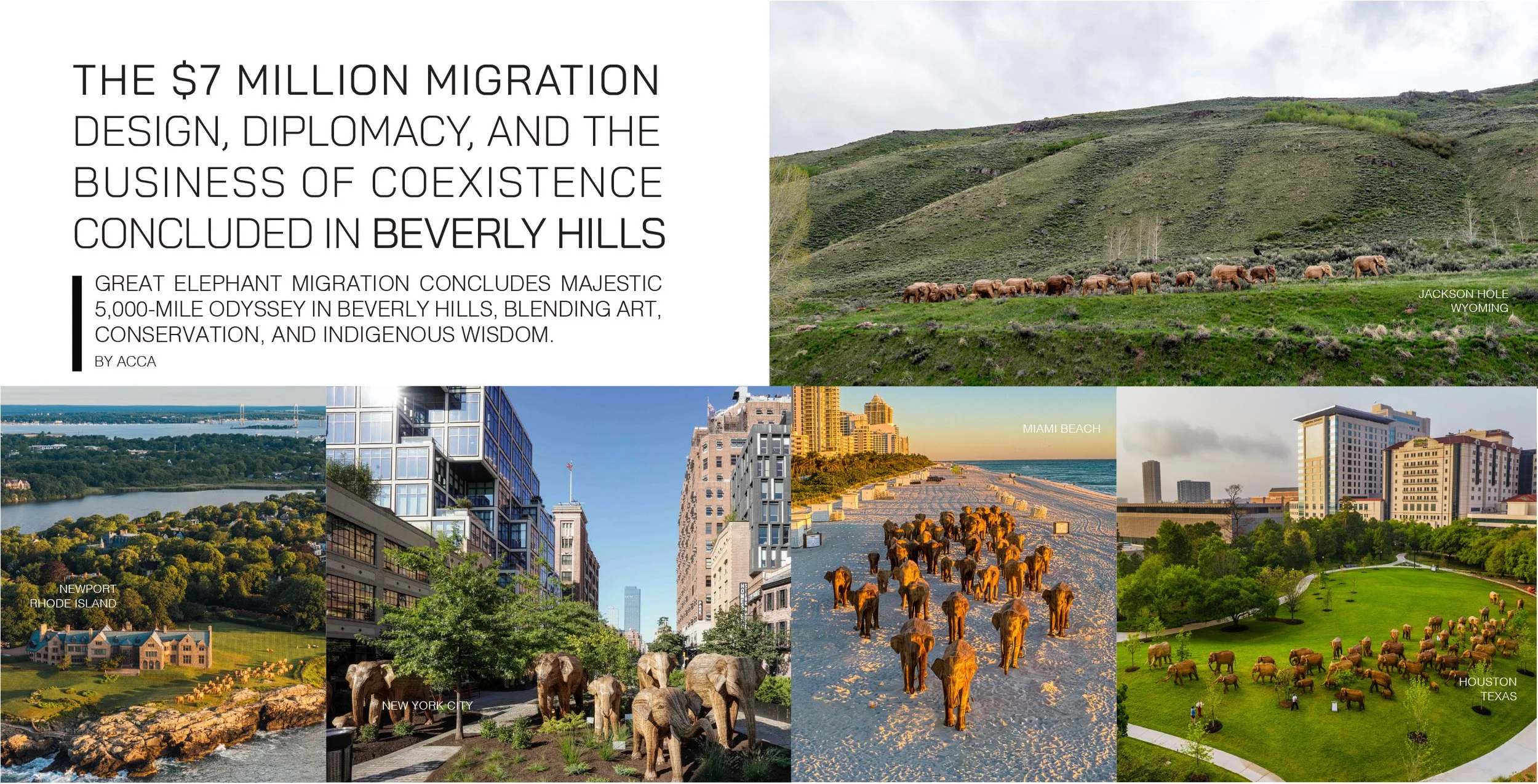The grand finale in Beverly Hills prominently featured a major cultural and design project: Wrapped in History. This initiative, curated by acclaimed Indian designer Vikram Goyal, was a global collaboration that produced over 70 bespoke ceremonial blankets. These textiles drew inspiration from South Asian, Indigenous North American, and diasporic textile traditions, transforming the sculptures "from sculpture into ritual".
Vikram Goyal, who is based in New Delhi, was known for advancing the art of metalwork, particularly the repoussé technique, by reimagining ancestral techniques for a modern context. Goyal extended his design ethos to textiles for this project, inviting collaborators spanning fashion, design, and Indigenous craft, including Ralph Lauren, Sabyasachi, Diane von Furstenberg, and the Navajo Nation. The blankets were ceremonially unveiled on the elephants at the Wallis Annenberg Center for the Performing Arts on June 27. The public had a chance to view the complete collection draped over the elephants on July 20 as part of Festival Beverly Hills.
The Business of Conservation Art
The Migration was fundamentally a global fundraising adventure designed to amplify Indigenous knowledge and inspire people to share space.
Financial Impact and Goals
The campaign operated by selling the life-sized elephant sculptures and associated design elements.
• To date, over 500 sculptures had been sold, generating more than $7 million for conservation efforts.
• The overall campaign goal was to reach $10 million by the end of 2025.
• Sculpture prices ranged from $8,000 for a baby elephant to $22,000 for a tusker.
Proceeds generated from the sale of the sculptures and the subsequent online auction of the Wrapped in History blankets (which ran from July 18 to August 1) benefited a network of over 20 human-wildlife coexistence projects in the U.S. and globally. Notable beneficiaries included the Coexistence Consortium, INDIGENOUS LED, Lion Guardians, and The Wallis Annenberg Wildlife Crossing. Wallis Annenberg, President and Chair of the Annenberg Foundation, supported the exhibit, noting that the Migration aligned with the Foundation's work on conservation and "increasing engagement with the arts through powerful communication".
Corporate and Cultural Partnerships
The project relied on strong partnerships bridging luxury, logistics, and conservation.
• Hertz, which was one of the world’s leading car rental providers, served as a key partner, powering the final 1,000-mile road trip across the American West with 25 pickup trucks decorated in vibrant Indian Lorry art.
• Chantecaille, a luxury beauty brand known for its botanical innovation and commitment to conservation, joined as a lead sponsor, helping fund the journey’s final leg and furthering the coexistence mission.
Archiving the Journey and Indigenous Wisdom
The migration's success in archiving stories about culture and coexistence was emphasized during its final ceremonial arrival. The final 1,000-mile road trip across the American West began on June 22 in Jackson Hole, WY, and culminated in Los Angeles on June 27. This final leg was guided by Matriarchs (a group including Cher, Diane von Furstenberg, and Wallis Annenberg), Maasai Warriors, and Adivasi artisans.
The journey itself created cultural archives along the way
• In Jackson Hole, Wyoming, the public participated in a farewell celebration and truck decorating ceremony in the vibrant Indian Lorry art style at the National Museum of Wildlife Art.
• In Salt Lake City, the convoy paused at Warm Springs Park, a sacred site for the local Ute tribe. Local Ute Matriarch and Utah State Representative Angela Romero spoke to the cultural and spiritual significance of this land.
• In Las Vegas, the convoy received a "Key to the Strip" from Clark County Commission Chair Tick Segerblom and a police escort down Las Vegas Boulevard.
• A meaningful penultimate stop was made at The Wallis Annenberg Wildlife Crossing in Agoura Hills, honoring the monumental conservation infrastructure under construction, which symbolized the global urgency of protecting migratory routes and creating safe passages for wildlife.
Upon arrival, Ruth Ganesh, Co-Founder of The Real Elephant Collective, spoke about the importance of braided knowledge, noting that the most impactful female leaders reminded us that leadership involved listening and learning from people who lived in deep relationship with the land. The project sought a "new frontier" where Indigenous wisdom and scientific knowledge were braided together to protect the natural world.
The migration concluded on August 1, 2025, with a public event hosted by Chantecaille, titled "Kiss Them Goodbye," which marked the final day of the Beverly Hills installation and the close of the Wrapped in History auction.


